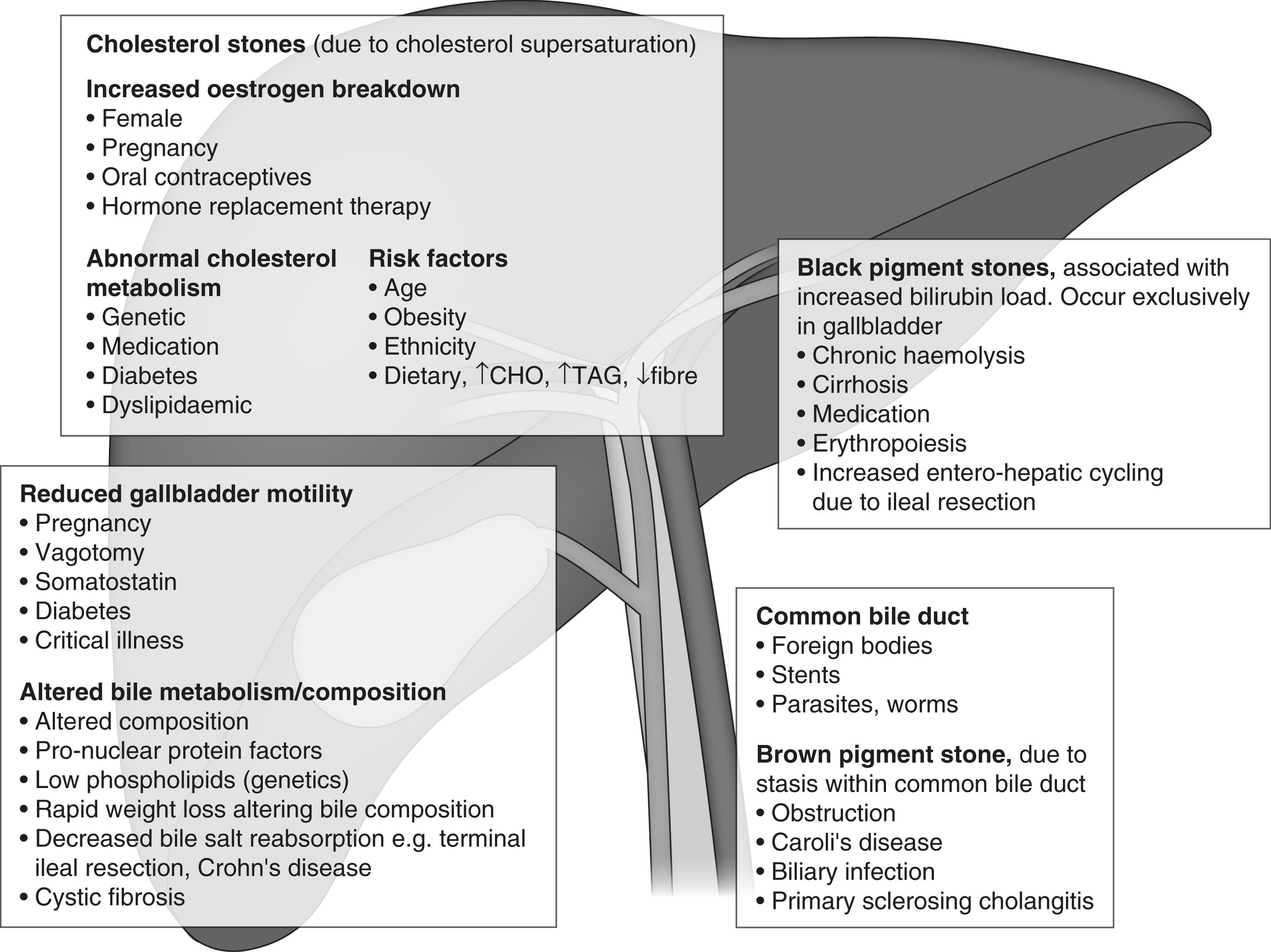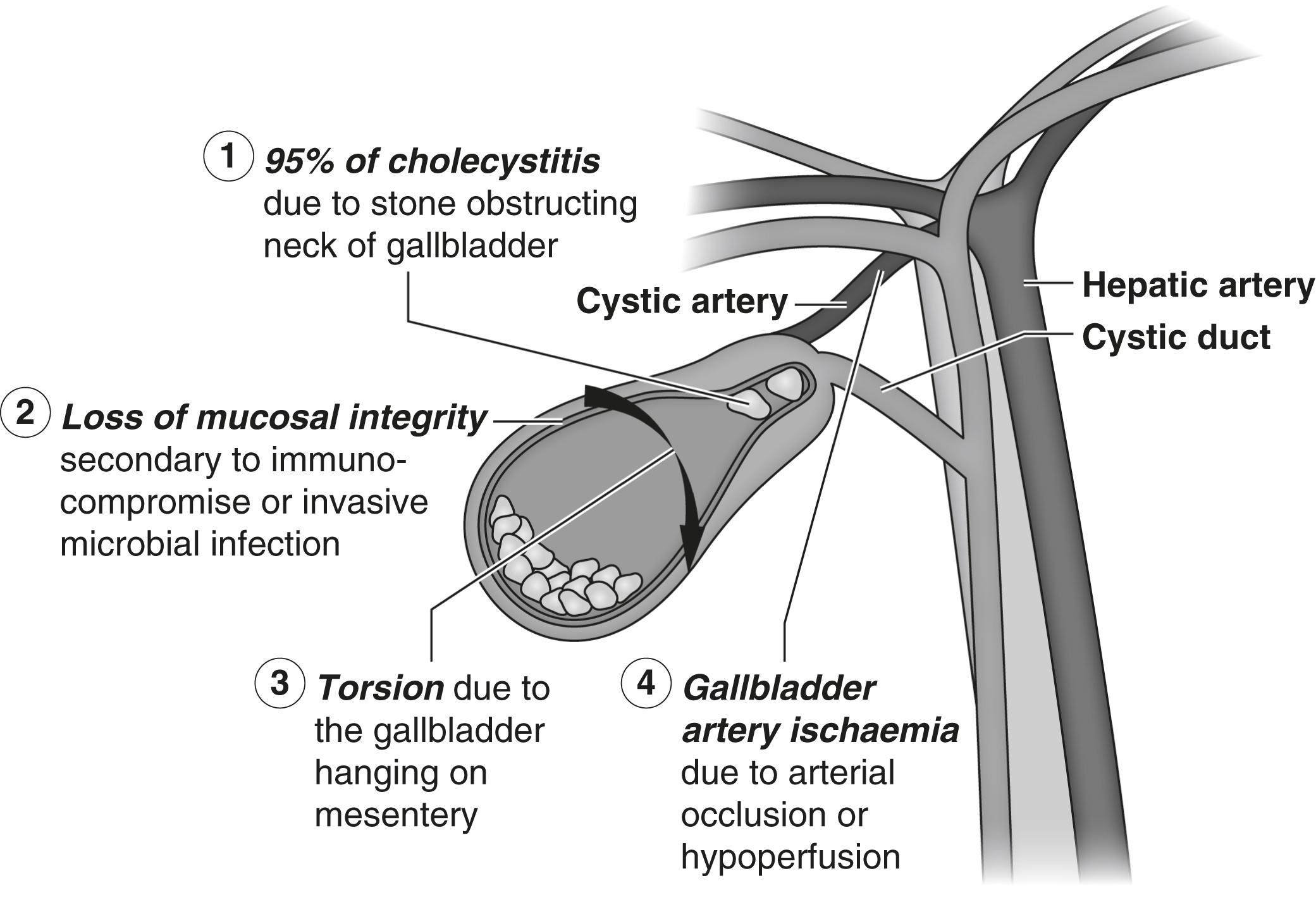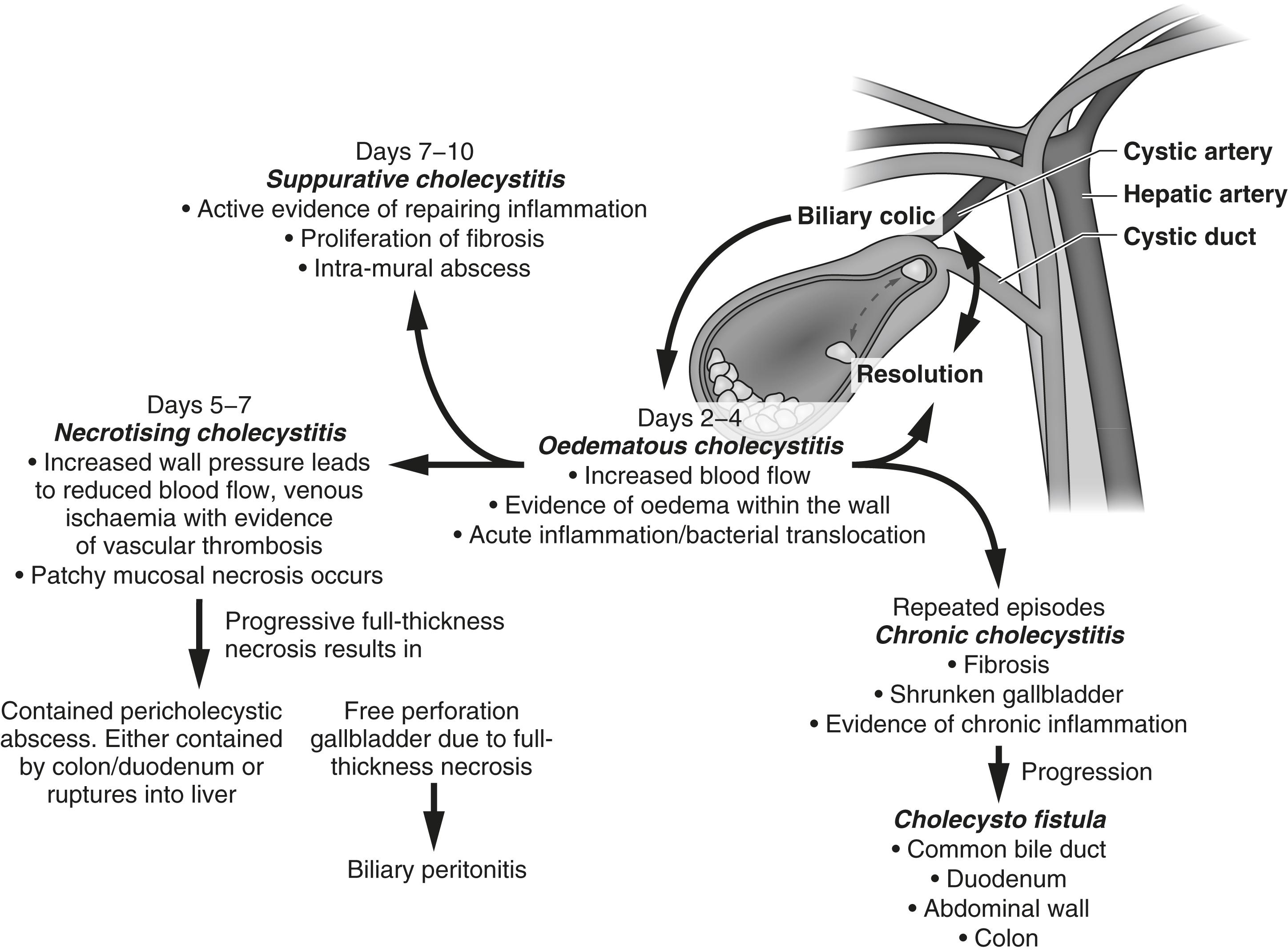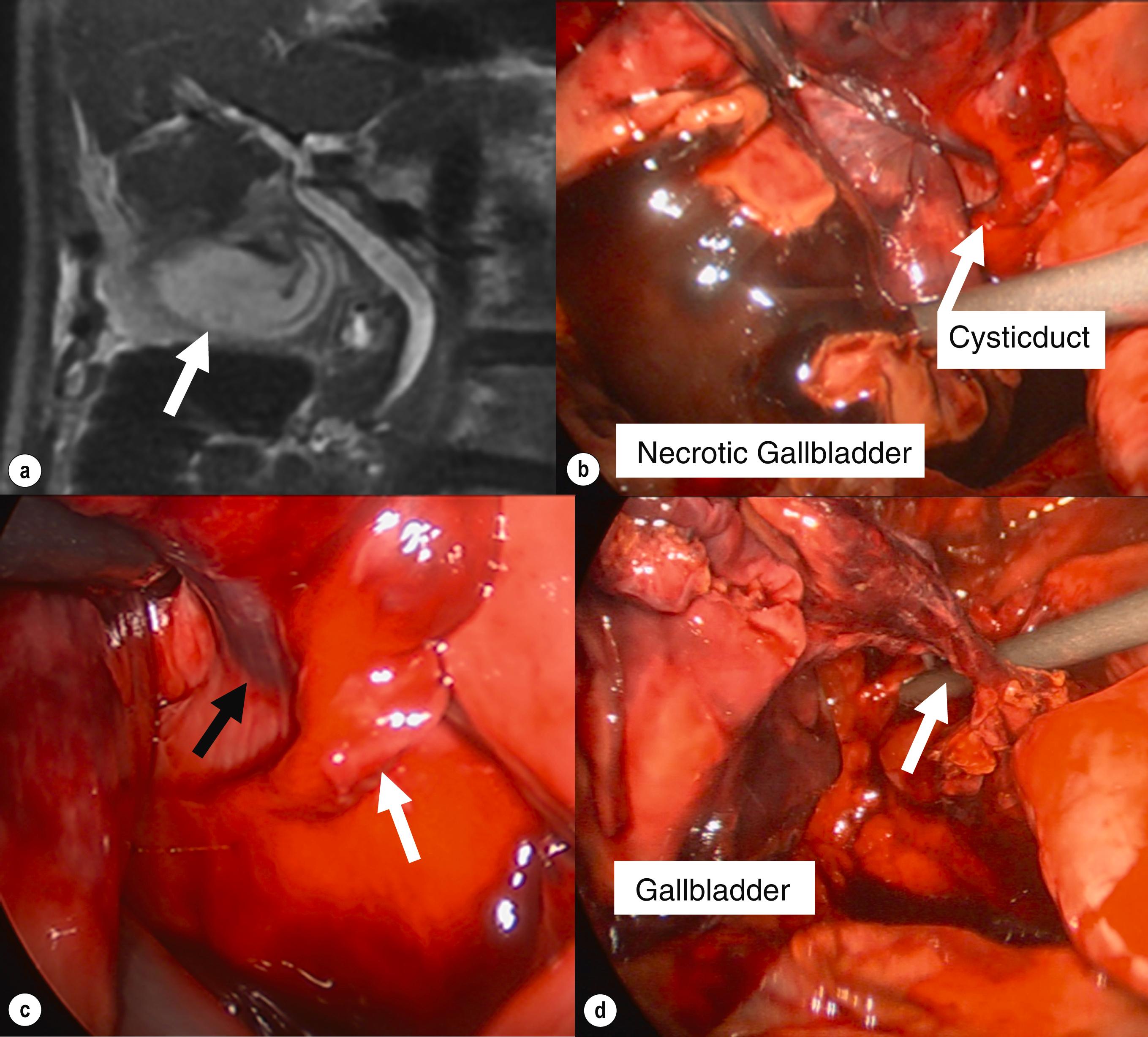Physical Address
304 North Cardinal St.
Dorchester Center, MA 02124
As a general surgeon it is important to be competent in the management of the common emergency presentations associated with calculous biliary disease as these patients comprise a significant component of the acute workload. In addition, recognising the patient who will benefit from specialised hepato-biliary-pancreatic (HPB) surgical care and transferring the patient after appropriate initial management is a key component of this process. The aim of this chapter is to provide an evidence-based approach to the management of acute calculous biliary disease and acute pancreatitis (AP) appreciating that the management of severe or complicated acute and chronic pancreatitis, pancreatic tumours and pancreatico-biliary trauma are dealt with in the HPB volume of the companion series.
The cumulative incidence of gallstones in the Western world has been reported as 0.60% per year with an overall prevalence of 9% in females and 10% in males. , Risk factors identified included increasing age, female sex, obesity, elevated non-high-density lipoprotein cholesterol and gallbladder polyps. The underlying contributing aetiologies and risk factors are shown in Fig. 14.1 . It is important to understand the differences in stone composition by geographical area or ethnicity. In parts of Asia, pigment stones predominate, while in Western countries mixed-type or cholesterol-based stones predominate. Although most gallstones remain asymptomatic, acute presentation can be divided into complications from local obstruction of the gallbladder due to cholecystolithiasis or migration of stones into the bile duct (choledocholithiasis) via the cystic duct.

The underlying aetiology and pathogenesis of biliary colic and its sequelae are shown in Figs. 14.2 and 14.3 , respectively. The commonest presentation is right upper quadrant (RUQ) pain with nausea or vomiting. Clinical examination reveals tenderness in the RUQ and the arrest of inspiration during palpation is known as Murphy’s sign and is associated with acute cholecystitis (AC). Biliary colic usually has a short history without signs of clinical or biochemical inflammation. As the disease progresses, RUQ peritoneal inflammation develops and systemic inflammation can be present either clinically or biochemically. Following development of a mucocele or empyema, an RUQ mass may be palpable although this is rare. The Tokyo guidelines are a series of international multi-society, multispecialty guidelines regarding the management of AC and cholangitis (also available as a mobile application). The 2013 Tokyo guidelines (TG-13) have defined a definitive diagnosis of AC as requiring a combination of clinical and imaging findings and were most recently updated in 2018 (TG-18) ( Table 14.1 ). The sensitivity and specificity of the TG-13 criteria for AC are 91% and 97%, respectively although the World Society of Emergency Surgery (WSES) guidelines have questioned the generalisability of these figures given the limitations of the supporting study. , Ultrasound (US) is the investigation of choice given its ubiquitous availability; however, the sensitivity and specificity in diagnosing AC are only moderate, reported as 81% (95% CI: 75–87%) and 83% (95% CI: 74–89%), respectively. In contrast, the sensitivity and specificity of US for detecting cholecystolithiasis is 84% and 99%, respectively. The key ultrasonographic findings of AC are thickened gallbladder wall (>3 mm), peri-cholecystic fluid and tenderness on gallbladder compression (radiological Murphy’s sign). Although nuclear medicine imaging has been shown to have higher sensitivity and specificity than ultrasonography, it is not widely used given its limited availability and practicality. More common alternatives include cross-sectional imaging such as computed tomography (CT) or magnetic resonance cholangiopancreatography (MRCP). CT findings indicating AC include gallbladder distension, wall thickening, subserosal oedema, mucosal enhancement or peri-cholecystic fat stranding. Other findings include transient focal enhancement of the liver adjacent to the gallbladder. This is due to increased blood flow and subsequent venous drainage through the draining cholecystic veins. Occasionally, gas will be seen within the gallbladder or within a peri-cholecystic abscess in event of contained perforation. Loss of gallbladder wall enhancement suggests gangrenous cholecystitis. Similarly, magnetic resonance imaging (MRI) is thought to be at least comparable with abdominal US in terms of accuracy; however, these conclusions are based on relatively poor underlying patient datasets. The TG-13 guidelines classified the severity of AC into three grades in an aid to guide management. Mild AC is defined as a healthy patient with no organ dysfunction or local complications. Moderate AC is defined as AC with local complications secondary to marked inflammation but without organ dysfunction. Local inflammatory complications include gangrenous or emphysematous cholecystitis, peri-cholecystic or hepatic abscess or biliary peritonitis. Severe AC is defined as AC with associated organ dysfunction.


| Local signs of inflammation | Murphy’s sign, RUQ tenderness, pain or mass |
| Systemic signs of inflammation | Fever, raised C-reactive protein or white blood count |
| Imaging findings | Characteristics of acute cholecystitis |
Markers of moderate AC include grossly elevated white count (>18000/mm 3 ), palpable mass or symptoms > 72 hours. An elevated C-reactive protein (CRP) has also been associated with severe inflammation. In large retrospective study ( n =1843), a CRP of > 67 mg/L predicted moderate and severe histological changes of AC with a 96% sensitivity and 100% specificity with an AUC of 100%. CRP also correlates well with gangrenous cholecystitis (CRP > 200 mg/dL has 50% PPV and 100% NPV, 100% sensitivity and 87.9% specificity) and gallbladder perforation.
![]() Elevated white count or CRP, symptoms > 72 hours or a palpable mass are predictors of complicated cholecystitis.
Elevated white count or CRP, symptoms > 72 hours or a palpable mass are predictors of complicated cholecystitis.
AC should be managed according to the TG-18 severity classification. In an updated evidence-based review of the literature, the authors of TG-18 recommend patients with mild AC undergo acute cholecystectomy if the patient does not have significant underlying comorbidity as defined by American Society Anesthesiologists (ASA) score or Charleston comorbidity index (CCI). Both TG-18 and WSES guidelines strongly recommend a laparoscopic approach for those with mild AC based on several randomised controlled trials (RCTs) and a meta-analysis showing better short-term outcomes with laparoscopic cholecystectomy (LC) as compared with open cholecystectomy. The WSES guidelines do, however, acknowledge the low level of evidence to support cholecystectomy per se as the standard of care and made the following statements with regard to other options in management of AC:
Antibiotics should be suggested as supportive care; they are effective in treating the first episode of AC, but a high rate of relapse can be expected. Surgery is more effective than antibiotics alone in the treatment of AC.
Surgery is superior to observation of AC in the clinical outcome and shows some cost-effectiveness advantages due to the gallstone-related complications and to the high rate of re-admission and surgery in the observation group.
Since there are no reports on surgical gallstone removal (cholelithotomy) in the setting of AC, surgery in the form of cholecystectomy remains the main option.
There is no role for gallstones dissolution, drugs or extracorporeal shock wave lithotripsy or a combination in the setting of AC.
For patients with moderate AC, LC remains the treatment of choice in experienced centres in patients deemed fit enough to withstand surgery (ASA ≤ 2, CCI ≤ 6). The authors of TG-18 rightly highlight some of the limitations of the data that were used to come to the above conclusion. Many of the trials had strict exclusion criteria based on patient comorbidity or complicated biliary disease and availability of surgeons skilled in LC. Surgeons should also be aware that although clinical and financial short-term outcomes are improved from an early approach to cholecystectomy, the trials and meta-analyses are underpowered to detect whether the incidence of bile duct injury (BDI) remains equivalent. A recently published population study from Sweden showed that overall the risk of BDI doubled (OR [95% CI] 1.97 [1.05–3.72]) for those with AC. However, when stratified by TG-13 severity, there was no increase in BDI for those with mild AC (OR [95% CI] 0.96 [0.41–2.25]), a twofold (OR [95% CI] 2.41 [1.21–4.80]) increase for moderate AC and an eightfold (OR [95% CI] 8.43 [0.97–72.9]) increase for those with severe AC.
The WSES guidelines and TG-18 address the issue of timing of LC. There is considerable heterogeneity regarding the definition of early versus late LC, especially regarding duration of symptoms versus time from admission. The WSES guidelines make the following statements:
Early LC is preferable to delayed LC in patients with AC as long as it is completed within 10 days of onset of symptoms. Earlier surgery is associated with shorter hospital stay and fewer complications.
LC should not be offered for patients beyond 10 days from the onset of symptoms unless symptoms suggestive of worsening peritonitis or sepsis warrant an emergency surgical intervention. In patients with more than 10 days of symptoms, delaying cholecystectomy for 45 days is better than immediate surgery.
![]() Laparoscopic cholecystectomy remains the treatment of choice for patients with acute cholecystitis. Early surgery is associated with reduced length of stay, reduced gallstone-related complications and a reduction in re-admissions due to ongoing symptoms.
Laparoscopic cholecystectomy remains the treatment of choice for patients with acute cholecystitis. Early surgery is associated with reduced length of stay, reduced gallstone-related complications and a reduction in re-admissions due to ongoing symptoms.
Population studies have shown benefits of early LC (defined as within 72 hours of emergency presentation) in terms of reduced complications, BDI, shorter length of stay and fewer re-admissions. Nonetheless, in TG-18 the authors removed the previous limitation of 72 hours on LC for moderate AC, instead suggest progressing with surgery irrespective of time if surgical expertise and patient comorbidity permit. For those patients deemed unfit for surgery, then conservative management with antibiotics for those with mild AC is appropriate, but the consideration of early and urgent percutaneous drainage (PTGD) should be considered for those with moderate AC.
For patients with severe local inflammation or severe AC, urgent gallbladder drainage should be carried out. However, it is important to be aware in the presence of biliary peritonitis, gallbladder torsion, emphysematous, gangrenous, or purulent cholecystitis, urgent surgery is required ( Fig. 14.4 ). TG-18 also makes adjustment to the recommendation for surgery in a select group of patients with severe AC. If a patient appropriately responds to resuscitative measures (no ongoing neurological or respiratory dysfunction), has appropriate ASA score (≤2) or CCI (≤3) and total bilirubin < 2 mg/dL and there is appropriate surgical expertise, then surgery can be considered.

In TG-18, the authors stress the new concept of de-escalation of antimicrobial therapy such that the antibiotic spectrum is narrowed as soon as sensitives of the underlying organism are known. Common organisms associated with biliary infections include Escherichia coli, Klebsiella spp. , Pseudomonas spp. and Enterococcus spp . For mild AC, ampicillin with aminoglycoside, cephalosporin, carbapenem or fluroquinolone based therapies are all potential options. Blood cultures are not required and antimicrobial therapy can be stopped once source control is achieved for mild AC. , For more severe infections, culture of bile, blood and, where possible, tissue are recommended. Piperacillin may be used instead of ampicillin. Duration should be extended for 4–7 days. A recent systematic review of the true role of antibiotics in AC also failed to come to definitive conclusions given low quality of evidence despite 12 randomised trials.
![]() The routine use of antibiotics in the management of acute cholecystitis remains unclear due to poor quality evidence. Antimicrobial therapy may be stopped once source control is achieved in mild and moderate AC. Systemic antimicrobial treatment should be continued for 4–7 days for more severe infections.
The routine use of antibiotics in the management of acute cholecystitis remains unclear due to poor quality evidence. Antimicrobial therapy may be stopped once source control is achieved in mild and moderate AC. Systemic antimicrobial treatment should be continued for 4–7 days for more severe infections.
When considering the role of PTGD, it is important to have considered the results of the CHOCOLATE trial. This was a multicentre RCT performed across 11 Dutch hospitals. The aim of this study was to compare PTGD with LC in ‘high-risk’ patients with AC. Although the authors used the TG-13 diagnosis of acute calculous cholecystitis, the definition of high-risk patients was defined as patients with an APACHE score between 7 and 14, excluding those patients with APACHE score > 14, with underlying cirrhosis or requiring ICU admission at the time of diagnosis of AC, or with symptoms > 7 days duration. All LC were performed by experienced surgeons. The primary outcomes were death within 1 year and occurrence of major complications within 1 month, or the need for re-intervention or recurrent biliary disease within 1 year. After recruitment met 50% of the trial target ( n = 138 patients), interim independent data analysis recommended cessation of the trial due to superior outcomes for those undergoing LC (major complications 8/66 vs 44/68 patients, RR [95% CI] 0.19 [0.10–0.37], P < 0.001). In addition, there was a significant increase in healthcare costs and resource utilisation. The question arising from this study is whether early elective cholecystectomy in those treated with PTGD could have improved outcomes. A recent population study showed a higher risk of overall complications and longer hospital stay in 1211 patients who underwent surgery within 8 weeks of PTGD compared with 1787 patients who underwent surgery after 8 weeks. BDI rate was high but not influenced by timing of surgery.
In patients who undergo PTGD, it is important to realise the effect of increased delay to drainage on short- and long-term outcomes. Yeo et al. have shown that increasing time to drainage increases both inpatient and 30-day mortality. While Yamada et al. demonstrated an increase in operative difficulty and conversion in those patients in whom drainage was delayed > 74 hours from onset of symptoms. Therefore, early decision-making regarding surgery or PTGD is required.
In a study of 103 patients with a median age of 80 years in whom PTGD was used, short- and long-term outcomes were described. The inpatient mortality was 13%, indicating the severity of disease and comorbidity in this group of patients. Eventually only 41% underwent cholecystectomy with a 15% rate of conversion. Wang et al. describe 279 (24%) patients who presented with AC undergoing PTGD. Of these patients, 3% died during initial illness and 31% underwent delayed cholecystectomy. Thus, 184 (66%) patients were deemed symptom-free (drainage into cystic duct and no symptoms after clamping) at follow-up and underwent PTGD removal. At 1 year, 60 (33%) patients had undergone LC, 5 (3%) patients had died and 17 (9%) patients developed recurrent AC. Factors associated with recurrent AC were complicated cholecystitis, antibiotic duration < 10 days and PTGD > 32 days.
![]() Acute cholecystectomy is the standard of care of ‘high-risk’ patients with acute cholecystitis. If percutaneous drainage is employed, the decision should be made early and subsequent elective cholecystectomy should be delayed longer than 8 weeks to reduce complication rates.
Acute cholecystectomy is the standard of care of ‘high-risk’ patients with acute cholecystitis. If percutaneous drainage is employed, the decision should be made early and subsequent elective cholecystectomy should be delayed longer than 8 weeks to reduce complication rates.
Although specific complications, such as emphysematous cholecystitis, mucocele, empyema, peri-cholecystic abscesses and cholecystoenteric (most commonly to duodenum or colon) fistula, can develop as a sequelae of AC, acute LC remains the standard of care. The exceptions are Mirizzi syndrome and gallstone ileus both of which deserve further consideration as the management differs.
Mirizzi syndrome is due to a large gallstone compressing or eroding into the common bile duct (CBD). It usually presents with symptoms and biochemical signs of AC or cholangitis. Mirizzi syndrome has been classified into four types based on absence (type 1) or presence of a fistula (type 2–4). Types 2–4 are split by degree of erosion of circumference of the bile duct, <1/3, <2/3 or complete destruction, respectively. The key concept is that there is a high probability that the hepatobiliary triangle has been obliterated due to fibrosis and so the surgeon must be aware that pursing the critical view of safety (CVS) and complete cholecystectomy may be dangerous and lead to BDI. If suspected on US (by the presence of intrahepatic duct dilatation with normal distal CBD and a large stone impacted in Hartmann’s pouch), then further imaging in the form of MRCP and MRI liver or CT should be considered. The MRCP should provide a detailed preoperative road map of the biliary and vascular anatomy so that a planned approach to the hepatobiliary triangle can be formulated. The MRI liver or CT should be added as the differential will include gallbladder malignancy.
In type 1, subtotal cholecystectomy can be performed, while types 2–4 likely require a hepaticojejunostomy. Thus, referral to a hepatobiliary surgeon is recommended for more advanced disease, especially if malignancy cannot be excluded. In a recent study of 169 patients with Mirizzi syndrome, the incidence was 2.1% of all cholecystectomies. Median duration of symptoms was 8 months. Presentation by types 1–4 was 20%, 57%, 17% and 6%, respectively. Of concern, only 32% of patients were diagnosed preoperatively. Important co-existent findings were 41% incidence of CBD stones, 14% incidence of coexisting fistula into adjacent hollow organs, 33% incidence of xanthalomatous cholecystitis and 5% incidence of gallbladder cancer. Those patients with Mirizzi type 2–3 who were treated without hepaticojejunostomy had higher rates of bile leak and a non-significant doubling of morbidity. The authors therefore concluded in favour of hepaticojejunostomy for type 2–3.
Gallstone ileus occurs after formation of a cholecystoduodenal fistula and migration of a large stone (>2 cm) into the small bowel lumen. The incidence is 0.3–0.5% of patients with cholelithiasis and is more common in female elderly patients. The distal ileum is the narrowest part of the GI tract and is the usual site of obstruction although proximal obstruction at the duodenal bulb can occur (Bouveret syndrome). Radiological signs include pneumobilia and a luminal calcified mass at the point of obstruction. Management of the bowel obstruction is not controversial with enterotomy and stone extraction the standard approach. However, it is worth noting that if possible the stone should be milked proximally to perform an enterotomy as the obstruction point is likely to be oedematous and potentially ischaemic secondary to pressure from the offending stone. A thorough search for upstream stones should be conducted. The dilemma is the management of the gallbladder and the cholecystoduodenal fistula. Historically, although a selective two-stage approach was recommended, a more contemporary approach is a single definitive procedure given high reported rates of recurrence and cholangitis. Most recommendations are however based on small patient series. A tailored approach is needed. In the frail, elderly or unstable patient at high risk of perioperative mortality, a simple enterolithotomy can be performed.
![]() In gallstone ileus, definitive simultaneous or metachronous management of the gallbladder may be determined by symptoms and presence or absence of cholecystolithiasis or choledocholithiasis.
In gallstone ileus, definitive simultaneous or metachronous management of the gallbladder may be determined by symptoms and presence or absence of cholecystolithiasis or choledocholithiasis.
In those with a clear CBD and empty gallbladder, spontaneous closure of the fistula may occur. Endoscopic management of choledocholithiasis by stone extraction with or without temporary covered stenting of a patent cystic duct may be appropriate for those with choledocholithiasis only. In those patients with persistent cholecystolithiasis, the gallbladder is likely to be shrunken and therefore formal dissection of the hepatobiliary triangle may be hazardous. Simply opening the fundus, extracting the stones, performing a cholangiogram (to ensure a clear CBD), closing the cystic duct if patent from within and then closing the duodenal fistula either primarily or with an omental patch would be the standard of care. Failure to assess the common duct may result in cholangitis once the fistula is closed if distal CBD obstruction remains.
There is an increased incidence of gallstones in patients with cirrhosis and such patients are at risk of increased morbidity and mortality from liver failure in the postoperative period which is proportional to the severity of the liver disease. In addition, in patients with portal hypertension, cholecystectomy carries a significant risk of haemorrhage. Therefore, consideration should be given to referring patients with cirrhosis and AC to HPB units familiar with perioperative management of liver failure and techniques associated with minimising bleeding during cholecystectomy including laparoscopic subtotal cholecystectomy.
During pregnancy, up to 0.8% of patients will present with symptomatic gallstone disease. Two systematic reviews and meta-analyses have reported no increased risk of preterm labour (3.8%) or foetal mortality (1.5%) associated with cholecystectomy and improved maternal and foetal outcomes with LC as compared with open cholecystectomy. , The data were unable to be analysed by presentation type, comorbidity or by gestational age. Recommendations were that in a well patient with non-complex disease, LC in first and second trimester would appear to be treatment of choice. A further American study using the National Inpatient Sample database identified 23 939 pregnant women with administrative coded cholecystitis. Of these patients, 36%, 60% and 4% underwent non-operative treatment, LC or open cholecystectomy, respectively. Significant improvements in outcomes were observed in those undergoing early LC. Importantly, each day delay to LC resulted in an increased daily risk of 1.173x for pre-term delivery, labour or abortion, 1.073x risk of antepartum haemorrhage, and 1.121x increased risk of amniotic infection. Unfortunately, no data was available regarding the gestational age, and those undergoing LC were clearly patients with improved access to healthcare. Although not specific to AC, Fong et al. did analyse outcomes for women presenting in third trimester with symptomatic biliary disease and compared those who underwent LC antepartum with those in early postpartum period. Both maternal and foetal outcomes were worse for those undergoing LC in third trimester and where possible the authors recommended delaying intervention until the postpartum period. Clearly involvement and support of obstetric, neonatal teams and ensuring the patient is well informed of the risks of all treatment options is a must.
![]() Laparoscopic cholecystectomy is the treatment of choice for uncomplicated symptomatic gallstone disease in the first and second trimester. Outcomes are worse in the third trimester and therefore intervention should be delayed until the postpartum period if possible.
Laparoscopic cholecystectomy is the treatment of choice for uncomplicated symptomatic gallstone disease in the first and second trimester. Outcomes are worse in the third trimester and therefore intervention should be delayed until the postpartum period if possible.
In terms of age alone, Fuks et al. retrospectively analysed 414 patients who had been enrolled in a non-related randomised trial and underwent LC for mild or moderate AC of < 5 days duration. Patients were divided by those older than ( n = 78) or younger than ( n = 336) 75 years of age. There was no difference in postoperative outcomes by age group, even in those greater than 85 years of age ( n = 20) or by performance status. The authors concluded that acute LC is safe in elderly patients with early mild or moderate AC. The WSES guidelines simply acknowledge age > 80 years as a risk factor for greater severity of disease, morbidity and mortality.
This is defined as AC without the presence of gallstones and is said to contribute 14% of all patients presenting with AC. The aetiology is not well understood but thought to be due to a combination of change in bile salt composition, loss of mucosal integrity and microcirculatory disturbances. Patients tend to be older with associated complications of atherosclerosis. Although traditionally associated with critically ill patients, up to 88% of patients will present from the community. Importantly there are higher rates of gangrenous cholecystitis (31%) than gallstone-induced AC (6%). For those who are fit for surgery, LC is the treatment of choice; otherwise PTGD is recommended. Importantly, the recurrence rates following conservative treatment are less than 2%, so delayed cholecystectomy is not usually indicated.
Become a Clinical Tree membership for Full access and enjoy Unlimited articles
If you are a member. Log in here